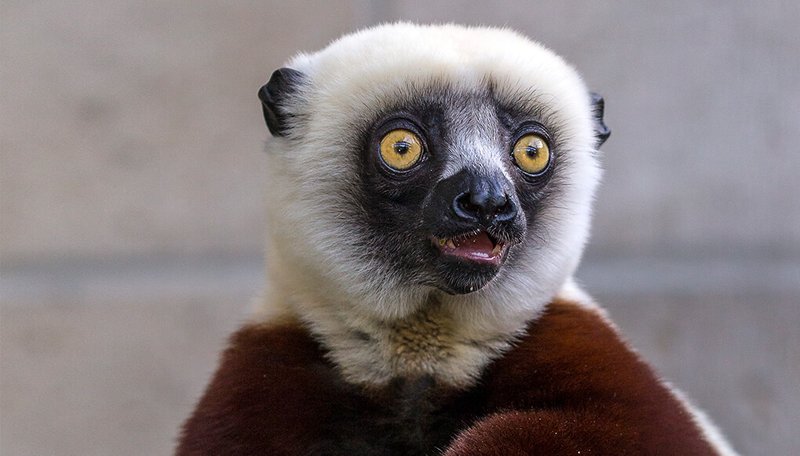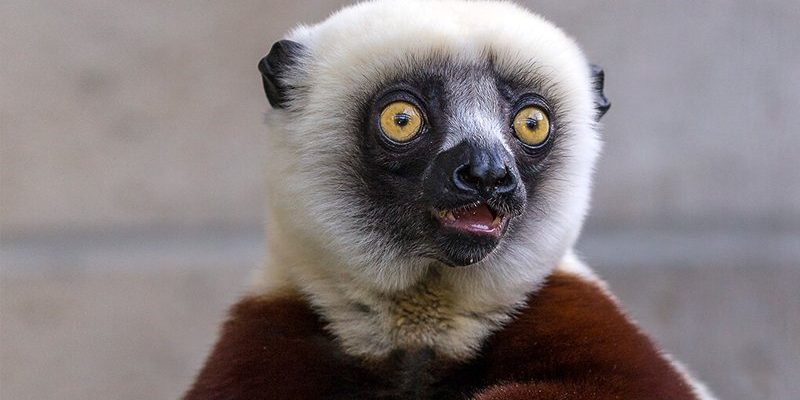
In this article, we’ll explore ten animals that are similar to the sifaka, diving into what makes each one unique and how to tell them apart. Whether you’re an animal lover or just curious, you’ll find plenty of interesting information that’ll help you appreciate these creatures even more. So, grab a comfy seat, and let’s jump into the world of these remarkable animals!
1. Indri
The indri is another lemur and is often considered the closest relative to the sifaka. Just like sifakas, indris have long limbs and a distinctive way of moving through the trees, gracefully leaping from branch to branch. One key difference, though, is their size—indris are larger, weighing up to 20 pounds!
You might also notice their unique vocalizations. While sifakas are known for their “dancing” and calls, indris have a haunting, melodic sound that travels through the forest. It’s like they’re serenading the jungle! If you spot one, look for their black and white coloration, which can help you identify them easily compared to the more varied colors of some sifakas.
Key Differences:
- Size: Indris are larger than sifakas.
- Vocalization: Indris have a distinct, melodic call.
- Color: Indris typically have black and white fur.
2. Woolly Lemur
Next up, we have the woolly lemur. These guys are a bit fluffier than sifakas, sporting thick fur that helps keep them warm in their cooler habitat. Woolly lemurs are primarily nocturnal, which is a stark contrast to the sifaka’s daytime antics.
One interesting fact about woolly lemurs is that they rely heavily on their sense of smell. While sifakas are quite visual and known for their impressive leaps, woolly lemurs often use their noses to navigate their environment. If you ever find yourself observing them, look for their bushy tails that often curl as they leap!
Key Differences:
- Fur: Woolly lemurs have thick, fluffy coats.
- Activity Time: They are mostly nocturnal.
- Behavior: They have a strong reliance on smell.
3. Black Lemur
The black lemur is another cousin of the sifaka, but there’s a twist! These lemurs come in two varieties: the black and the brown. The black ones sport sleek, dark fur, while the brown ones have a warm, chestnut color. Despite looking quite different from the sifaka, they share similar habitats and behaviors.
What sets black lemurs apart is their striking face, especially in males, which can have bright orange eyes. This difference in color and eye color can help you tell them apart easily. They also have a more agile way of moving, allowing them to nimbly navigate through the dense foliage.
Key Differences:
- Color: Black lemurs have distinctive dark fur and bright eyes.
- Agility: They navigate through trees more nimbly.
- Varieties: They come in both black and brown forms.
4. Ring-tailed Lemur
The ring-tailed lemur is probably the most recognized of all lemurs, thanks to its iconic black-and-white striped tail. Unlike the sifaka, ring-tailed lemurs are terrestrial, often found foraging on the ground rather than leaping high in the trees.
Their social structure is another fascinating aspect. They live in large groups, and it’s not uncommon to see them basking in the sun, using their tails as a sunshade. While sifakas may seem solitary in their elegance, ring-tailed lemurs thrive in their tight-knit communities.
Key Differences:
- Tail: Ring-tailed lemurs have distinctive striped tails.
- Habitat: They often forage on the ground.
- Social Behavior: They live in large groups, unlike sifakas.
5. Tarsier
If you’re looking for a creature with some serious big-eyed charm, the tarsier fits the bill. While tarsiers aren’t lemurs and aren’t from Madagascar, they share a similar tree-dwelling lifestyle. Known for their enormous eyes that help them see in low light, tarsiers are also nocturnal like the woolly lemurs.
What really differentiates tarsiers is their unique head rotation—they can turn their heads almost 180 degrees! Imagine being able to see behind you without moving your body. Their agility and small size allow them to leap like sifakas, but they have a much different appearance with their long fingers and wide-set eyes.
Key Differences:
- Eyes: Tarsiers have large eyes suitable for night vision.
- Head Movement: They can turn their heads almost 180 degrees.
- Physical Type: They have long fingers for climbing.
6. Colobus Monkey
The colobus monkey is another tree-dweller that shares some traits with the sifaka. Like sifakas, colobus monkeys have long limbs and are excellent at moving through the trees. Their most striking feature is their long, flowing tails that they often use for balance as they leap.
Colobus monkeys are often seen in large groups, which enhances their social nature. They’re also known for their unique digestive system that helps them process leaves more efficiently. Compared to sifakas, their black-and-white coloration is distinct, making them easy to identify in their forest homes.
Key Differences:
- Color: They have black-and-white fur.
- Group Behavior: Colobus monkeys often move in large groups.
- Diet: They can process leaves effectively.
7. Gibbon
Gibbons are often referred to as the lesser apes and have a lot of similarities to sifakas. They’re also fantastic jumpers and swingers, using their arms to help them zip through the treetops. Their long limbs and lightweight bodies give them an advantage in acrobatics, much like the sifaka.
It’s interesting to note that gibbons are highly social animals, known for their beautiful duets. Their songs can fill the jungle, creating a tremendously lively atmosphere. If you see a gibbon, you’ll notice their more “ape-like” face and lack of a tail, setting them apart from their lemur cousins.
Key Differences:
- Physical Structure: Gibbons have no tails.
- Vocalization: They are known for their beautiful songs.
- Agility: Gibbons can swing through trees with impressive speed.
8. Spider Monkey
Ever seen a spider monkey? These monkeys are known for their long limbs and prehensile tails, which they use like an extra hand to swing through trees. Spider monkeys can reach high speeds, much like the sifaka when it leaps, but their approach to movement is more about swinging than jumping.
One thing that sets spider monkeys apart is their dark, often spotted fur and their large, expressive eyes. They socialize in groups, much like the ring-tailed lemur, adding to their charm. If you happen to catch a glimpse of them in action, you’ll see why they earn their name—their movements are both graceful and spider-like!
Key Differences:
- Tail: They have prehensile tails for better grip.
- Movement: They swing through trees rather than leaping.
- Visuals: Spider monkeys have dark fur and striking eyes.
9. Capuchin Monkey
The capuchin monkey is a small, intelligent primate often seen in movies and TV shows. These monkeys have a different look from the sifaka, with their light-colored faces and dark bodies. Capuchins are incredibly dexterous, using their hands to manipulate objects, which can be quite entertaining to watch.
Their social behavior is another highlight. Typically found in small troops, capuchins communicate through a range of sounds and expressions. While sifakas are more about graceful movements, capuchins are known for their clever tricks and problem-solving skills. If you see one playing with a tool, you’ll understand why they’re often called the “little genius” of the primate world.
Key Differences:
- Intelligence: Capuchins are known for their problem-solving abilities.
- Appearance: They have a striking light face and dark body.
- Behavior: Often engage in playful and clever activities.
10. Aye-Aye
Last but definitely not least, the aye-aye is one of the most unique primates you’ll ever encounter. With a long, thin middle finger, the aye-aye taps on trees to find insects hiding beneath the bark. This foraging method sets it apart from sifakas, who leap and dance around.
Aye-ayes have a more eerie look, with large eyes and shaggy fur, making them a bit different in the cuteness department. They’re nocturnal, which means you’re unlikely to see them during the day, but if you do catch a glimpse, their unusual antics and feeding behaviors are worth watching!
Key Differences:
- Unique Finger: Aye-ayes have a long middle finger for tapping.
- Appearance: They have a shaggy look and larger eyes.
- Nocturnal Behavior: They are active during the night.
In conclusion, while sifakas are certainly fascinating creatures, they share the stage with a variety of other remarkable animals. Understanding the similarities and differences among these species can deepen our appreciation for the animal kingdom. So, whether you’re on a safari, visiting a zoo, or simply exploring nature, keep your eyes peeled for these amazing creatures! You never know when you might spot one and learn something new about them.

